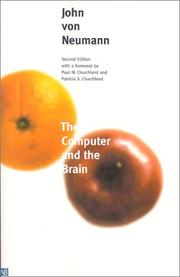Check nearby libraries
Buy this book

This second edition has a foreword by Churchland & Churchland (c) 2000
Check nearby libraries
Buy this book

Previews available in: English
Subjects
Nervous system, Computers, Cybernetics, Ciencia Da Computacao Ou Informatica, Cybernétique, Sistemas De Computacao, Cerveau, Système nerveux, Engenharia Biomedica, Sistema Nervoso Central, Brain, Informatique, Ordinateurs, Ordinateurs neuronaux, Physiology, Neurale netwerken, Automatic Data ProcessingPeople
John von Neumann, Alan TuringTimes
1956Showing 3 featured editions. View all 12 editions?
| Edition | Availability |
|---|---|
|
1
The computer and the brain
2000, Yale Nota Bene
Softcover
in English
- 2nd ed.
0300084730 9780300084733
|
aaaa
Libraries near you:
WorldCat
|
|
2
The Computer and the Brain (The Silliman Memorial Lectures Series)
September 10, 1979, Yale University Press
Paperback
in English
- New Ed edition
0300024150 9780300024159
|
zzzz
Libraries near you:
WorldCat
|
| 3 |
eeee
|
Book Details
Table of Contents
Contents.
Foreword to the Second Edition.
Preface, by Klara von Neumann.
Unusual Basic Operations 4
Edition Notes
Classifications
Contributors
The Physical Object
ID Numbers
Community Reviews (0)
Feedback?| December 10, 2023 | Edited by MARC Bot | import existing book |
| June 21, 2023 | Edited by OnFrATa | Merge works (MRID: 61536) |
| February 14, 2020 | Edited by MARC Bot | remove fake subjects |
| July 6, 2019 | Edited by ImportBot | import existing book |
| December 9, 2009 | Created by WorkBot | add works page |












